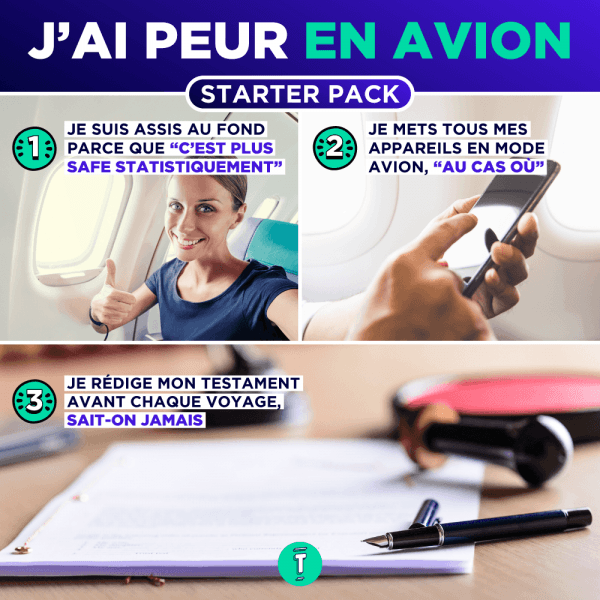The cabin crew makes many people fantasize: being paid to travel around the world and sleeping in hotels that are never disgusting, of course… It’s a dream come true. But I will quickly calm you down: this is only a tiny part of their daily life. In reality, it’s a much tougher and tougher way of life than you might think. Go ahead, please, stay up, on high heels, for 12 hours, and keep smiling, even in front of very uncourteous travelers! I’m looking at you.
1. To get the exam, you have to pass lifesaving tests
To fly, you have to know how to… swim! You weren’t expecting this one, were you? Well, it’s part of the practical test to get the exam. The hostesses and stewards must show that they are able to tow a person wearing a lifejacket in the water for 25 meters after having equipped themselves in a limited time, or simulate boarding a dinghy. rescue. Less than 6/20 in this test results in the elimination of the candidate.
2. … And security challenges
Among the practical tests, there is also that of medical first aid, then that relating to safety in aeroplanes. This time, the candidates pass a timed exercise of progress in a smoky enclosed space and an extinction of a low fire then a high fire by extinguisher.
Cumulatively (swimming + safety + medical aspects), you must obtain at least 12/20 to qualify.
3. Some companies even provide defense training
It happens that the crew members are confronted with various crisis situations: anxious passengers who lose their means, alcoholic travelers more than reason, aggressive people (verbally as physically),… To control these situations, a few thousand meters above the ground, some airlines call on close security specialists to train the cabin crew and teach them a few attack-defense techniques.

4. They can chain up to 5 flights a day
Admittedly, the flight attendants travel more than all of us, but it’s really not easy: they can chain up to 5 flights a day in low cost companies, and work 15 hours in a row. And that’s not all ! On long-haul flights, they also have to deal with jet lag, and assume a life without schedules: they can start a day at 4 a.m., then at 7 p.m. other times, board a flight of a few hours or a half-day trip,… No routine, fatigue and stress.
5. Holidays do not exist
With the exception of May 1, which is paid double, all the other days of the year are also paid. No Christmas, National Day or New Year’s Eve paid double. Solo family celebrations, paid for in the same way as April 4th. Or that a June 3rd. Or a July 16. Or that a… You have it.

6. They have no fixed colleagues
The crews are never the same, the hostesses and stewards do not really have colleagues with whom they can share their daily lives. Obviously, the smaller the company, the more likely they are to meet again in flight. Conversely, in the national companies which hire nearly 20,000 flight personnel, this is less likely.
7. They have on-call duty
Once again, everything depends on the company, and the nature of the flights, but in all cases: the hostesses have on-call duty, in other words: days during which they can be mobilized at any time, and on site less than an hour, to join a flight.
8. In flight, they can rest in small cabins
On long-haul flights, the hostesses and stewards have the possibility of sleeping for a few hours, in small rooms made up of superimposed berths, exclusively reserved for this staff. Depending on the duration of the flight, they have 30 minutes to 3.5 hours of sleep. Yes, it’s not huge.
9. Stopovers can last from 12 hours to several days
Up to 7 days, depending on destination and company. In this case, the flight personnel are housed in a hotel by the company for which they work. The choice of location is not insignificant: staff representatives ensure the quality of rest, internet access, catering options, etc.
10. …Besides, some hotels have a living area reserved for crews
This is what this hostess says, documenting her daily life on TikTok. These are generally large living spaces in which the various crew members can meet to rest, eat and have fun.
11. There are many rules for wearing a uniform.
Each company has its own rules and uniforms. The hostesses and steward have precise instructions as to their dress, their make-up, their hairstyles, the women are sometimes obliged to wear varnish and tights (This is what Claire, hostess in a French national company, in what a podcat, around 9’50 min). In 2019, the Virgin Atlantic company decided to lighten its rules and leave the choice of lightening makeup and wearing pants to its hostesses.
Also note that other physical criteria are taken into account: in the majority of companies, women must be between 1m60 and 1m78, and men between 1m70 and 1m90.
12. They are at least bilingual
This is one of the main recruitment conditions. Crew members are often asked to have obtained a score of at least 730 to 760 points out of 990 on the TOEIC. Knowledge of other additional languages is always a plus. On a daily basis, the hostesses must work on their foreign language skills to maintain an excellent level.

13. Flight attendants should watch out for “suspicious passengers”
Flight attendants are trained to spot suspicious activity. When they greet you at the entrance to the plane, they don’t just say “hello” and wish you a pleasant flight: they are watching. In this way, they also carry out a manual passenger count and find out who will have specific needs on board (travellers with disabilities, young children, elderly people, etc.)



